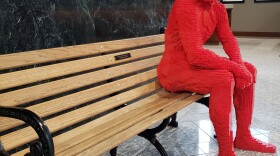Joan Prusse, interim director at the Clyfford Still Museum, was prepared for the news she and several other Denver cultural organizations received Wednesday: Denver’s move to Level Red on the COVID-19 risk dial meant as of 5 p.m. Friday they would have to close for at least the next four weeks.
“It didn’t come as a surprise to me with the rates as they were,” Prusse said. “I found it hard to imagine that the regulators would look at the holidays and think, ‘Oh, things are just going to be better.’”
Still, it wasn’t easy to hear.
“I won’t lie, it’s a real disappointment because we really enjoy the holiday season when typically a lot of our local community have friends and family from out of town and bring them to the museum,” she said.
Earlier this week, Colorado Gov. Jared Polis announced that 15 counties were moving to Level Red due to increasing COVID-19 numbers. That meant new restrictions, like closures for indoor dining and “venues,” which include some museums such as the Museum of Contemporary Art Denver and the Kirkland Museum of Fine & Decorative Art.
“There is, I think, frustration by many leaders of cultural organizations in finding themselves grouped with other indoor events that are — in our view — pretty dissimilar from a museum experience,” Prusse said. “We feel that visiting a museum is possible to be categorized differently than going to a gym or visiting a non-essential store.”
What has been your biggest #conservation challenge to date? #AskAConservatorDay
— ClyffordStillMuseum (@Still_Museum) November 18, 2020
Pam Skiles, Senior Paintings Conservator: This one is easy since I just finished working on it! Still's PH-260 was an incredible challenge. (1/5)
Photo: Skiles working on PH-260. pic.twitter.com/o1ZsRWNB9E
In addition to a robust virtual program, among the steps taken during the first closure back in March, the museum created a timed ticketing system, added signage, established social distancing and cleaning protocols and limited capacity to just four people admitted every 15 minutes. They even consult with a former CDPHE epidemiologist to make sure they are following up on the very latest health and safety measures.
“We believe that science is the answer to this and it makes a difference,” Prusse said. “And we want to be as informed and up to date as we can be.”

At the Museo de Las Américas, it’s a similar story.
The museum, which just weeks ago opened its latest exhibit, “Testigos/Witnesses,” follows strict protocols and has a capacity of just a handful of total visitors under the previous restrictions, said executive director Claudia Moran.
While some may wonder if it’s worth it to stay open for such a small number of people, Moran says if it means they can continue to support artists and the community, it is.
“This is what we work for,” she said.
Moran added that she’s optimistic that further conversations between the smaller museums and city and state regulators could help. While it won’t change the current situation, she hopes that it might lead to changes in how restrictions are implemented should another closure be warranted.
While larger institutions — like the Denver Museum of Art and the Museum of Nature and Science — are operating under a separate, site-specific variance, even they are trying to figure out what these new restrictions could mean for them.
“We are seeking clarification from city and state officials to ensure we are taking the right steps,” spokesperson Jena Pruet stated in a written statement to KUNC. “The museum will continue to operate on current reduced capacity, and continue to focus on creating the safest possible in-person environment to experience art.”
Whether it's virtually or in-person, Moran said continuing with the museum’s current exhibits and programming is critical — especially for its youngest visitors.
Over the summer, the museum not only created an entirely new system for virtual programming, but also worked with communities to make sure that children had access to those programs, Moran said. That included providing curbside pick-up of materials and even tablets and laptops for those without a way to access the internet at home.
“We knew that for those mornings, back in June, the children were by themselves at home so Museo was challenging to create and put in place the technology that we didn’t have in order to serve those communities and families,” she said.





